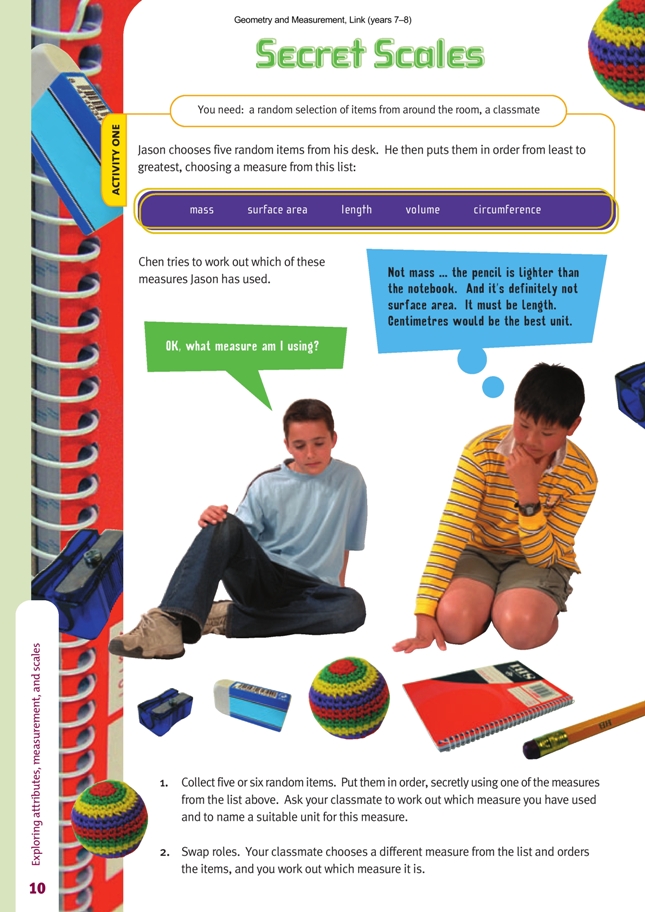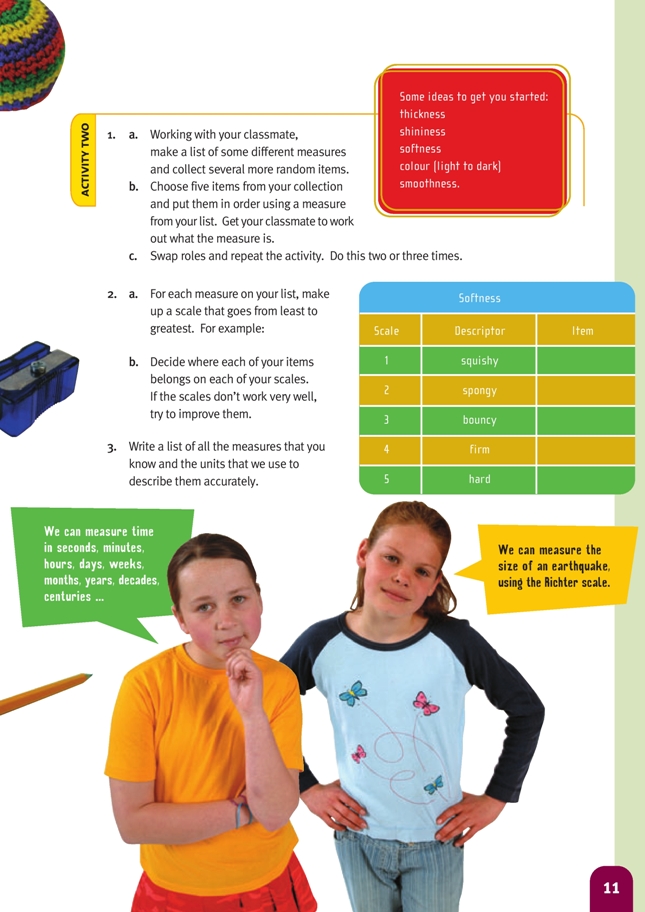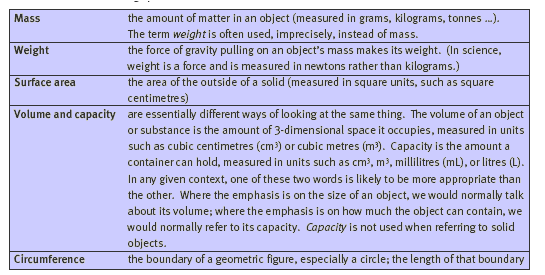This is a level 3 link measurement activity from the Figure It Out series.
Click on the image to enlarge it. Click again to close. Download PDF (783 KB)
explore measurement attributes of objects
FIO, Geometry and Measurement Link, Secret Scales, page 10
classmate
Activity One
To introduce the activity and to help the students clarify what is meant by each of the measures in Jason’s list, find five objects of your own and ask the students: “If I were going to put these in order from least to greatest according to their mass (weight), which object would I put at the least end? Which object would I put at the greatest end?”
By doing this, you will see which students need the term mass clarified. Repeat the questions for surface area, length, volume, and circumference.
The following words play an important role in this activity. Teach them, using examples. List and display them on a chart. Encourage your students to use them:
After the students have ordered their own items and shared the guessing role, ask:
- What strategies did you use to put the objects in order?
- Which objects and measures did you find hard to order? Why?
- Do you have an object that was at the greatest end of the order for one of the measures but at the least end for another measure? Which one?
Activity Two
If your students find it difficult to think of other measures, treat question 1a as a task for the whole group and write all ideas on the board. Ideas could include: height, number of visible words, holeyness, multicolouredness, number of component parts, redness, cost (monetary value), bendiness. Once the brainstorming has run its course, get the group to edit out any measures that are likely to be unusable. When
the students go off in pairs to complete question 1, they should agree on the list of measures that they will use and write it down. It doesn’t need to contain every suggested measure; each pair could limit their list to five or six measures.
Question 2 asks students to try to develop scales for their different measures. You may need to clarify for them the essential features of a scale:
- It consists of an ordered series of gradations (steps) or benchmarks (descriptors).
- These steps have equal intervals (gaps) between them.
- Its purpose is to measure something.
Measurements are made by comparing the attribute (quality or characteristic) being measured against the steps or benchmarks on the scale.
Students may not have all the words they need for the descriptors on their scales. If this is the case, they may find a thesaurus helpful.
A possible approach to question 3 is to divide the students into groups of 3–4 and give each group a pile of memo cube squares or stickies. Give the groups a few minutes to write down as many different standard units as they can think of, one per square or sticky. The next task is to classify the units according to the attribute that each one measures. The final task is to sort each class of units into their correct order from least to greatest.
Give the students time to look at, compare, and talk about the results of their brainstorming. Then try a “spying mission”: half the students from each group walk around looking at the work done by other groups, talking to those who have stayed put, and making notes about things they want to incorporate into their own work. Then give them time to finalise details and to stick the ordered lists of units, in their categories, onto large sheets of paper for display.
Extension
This activity is an effective generator of questions for independent investigation; students can record these questions on their charts as they arise. You could generate further questions for investigation by asking students what units are used to measure things like electricity, angles, temperature, force, speed, light, pressure, sound, fuel consumption, and so on. (See the Answers.)
Suggest to students that they enter “metric measurement” + history in an Internet search engine. By exploring some of the sites that are listed, they will be able to find out about how the metric system of measurement was adopted following the French Revolution. Nearly all countries now use this system, which was originally based on the Earth’s size and other physical attributes and designed so that the different units related sensibly to each other. Using it, calculations are so much easier than they were with historical units. Students could also discover that the USA still uses many non-metric units (such as ounce, gallon, and mile) and the reasons for this.
Answers to Activities
Activity One
1.–2. Practical activities
Activity Two
1.–2. Practical activities
3. Answers will vary. You might include: angle (degrees and minutes), temperature (degrees Celsius), electricity (volts, amps, ohms), force (newtons), speed (m/s, km/h), light (lumens), pressure (pascals, millibars, atmospheres), acceleration
(m/s2), sound (decibels), fuel consumption (L/100 km).


